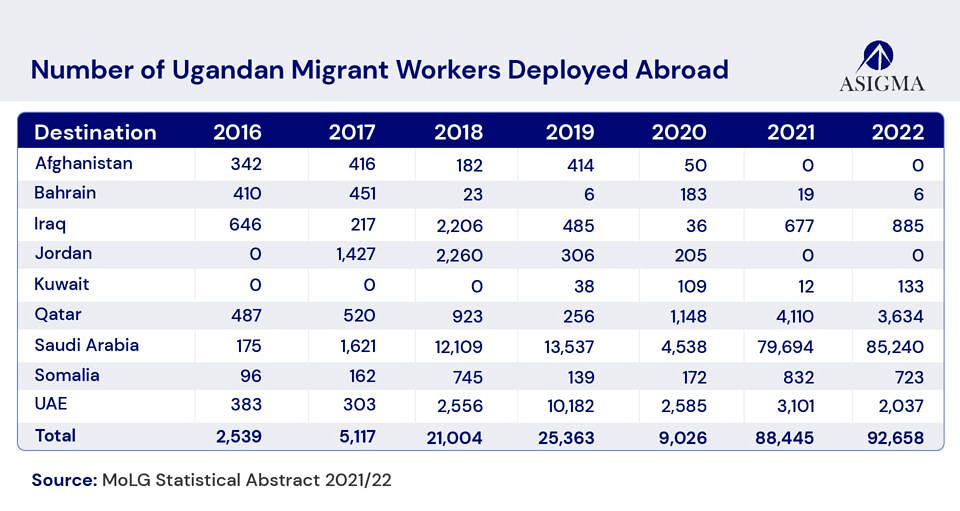Labour productivity – the silver bullet to Uganda’s low-skilled international migration
May 22, 2024

Labour migration is becoming an increasingly important policy concern within the current geo-political environment. The International Labour Organisation (ILO) estimates that there are over 169 million migrant workers globally. This presents a myriad of macro-economic opportunities and challenges to labour destinations and countries of origin.
Migrant workers contribute to growth and development in their host countries, while their countries of origin also reap benefits in terms of remittances and skills acquired in their migration experience. On the other hand, labour migration undermines the demographic dividend of countries with youth majority populations such as Uganda and exposes migrant workers to exploitation. Statistics from ILO show that on average, migrant workers earn 25% less than their counterparts and face triple the risk of forced labour.
Over the last two decades, Uganda has witnessed a rise in the number of her citizens – majority unskilled or semi-skilled, travelling abroad for work. According to the Ministry of Gender, Labour and Social Development, the number of migrant workers deployed abroad nearly grew tenfold from 10,000 in 2010 to almost 93,000 in 2022. The Middle East is the preferred destination for Ugandan immigrant workers with Saudi Arabia receiving the lion’s share of Ugandan workers since 2018.

Whereas several factors account for the influx of Ugandan immigrant workers in the Middle East, the president has at various local and foreign engagements cited laziness as the underlying cause of Uganda’s unemployment and labour migration problem. This sentiment was reechoed at this year’s Labour Day celebrations under the theme “Improving access to labour justice, a prerequisite for labour productivity” address.
The president cited that Ugandans suffer from a lack of vision as opposed to a lack of jobs, particularly in response to Ugandans seeking employment in Arab countries. Over 25,000 Ugandans travel to the Arab Gulf States seeking employment every year. This therefore calls into question the country’s labour productivity.
Labour productivity represents the total volume of goods and services (measured in terms of GDP) produced per unit of labour (measured in terms of number of employed persons) during a given time reference period. It is an indicator of the efficiency of a country’s workforce, providing a measure of the average output generated per worker and is closely linked to economic growth, competitiveness, and living standards within a country.

The average labour productivity in these states is $41 while that of Uganda stands at $3.53 (UGX 13,200) for every one hour of work, Uganda’s labour productivity is among the lowest globally and within the EAC. Uganda’s low labour productivity can be attributed to the high levels of informality in the labour sector, where many employers overlook labour market regulations, hence placing workers in ‘vulnerable’ employment categories. This is additionally exacerbated by the low levels of skilling owing to a limited tertiary level education and vocational education for almost 90% of the population. The associated low skills gap leaves most of the working population employed in low-value services which are labour intensive but less productive. These include petty trade, food vending as well as “traditional” subsistence agriculture which employs 72% of the population. Only a fraction of the population is able to secure employment in high value-added economic activities like agro-processing, horticulture, or tourism.
The low levels of skilling in Uganda can be attributed to the high costs of education and training, social and cultural norms that discourage the attainment of education as well as low adaptation of technology in education. There is a need to improve the quality of basic education in the country as a basis for skills development and ultimately, for productive employment as well as ensure universal enrolment of youth in elementary education. Ensuring universal enrolment in elementary education is important considering Uganda is associated with high primary level dropout rates which have resulted in low transition rates overall between primary and secondary school. The primary school dropout rate stands at 38.5% which has directly contributed to an increase in the number of unskilled Ugandans joining the labour market and weakens the benefits of later-life skill training. Elementary-taught skills such as literacy and numeracy skills play an important role in further skills development.
Furthermore, in a technologically advancing world, there is an urgent need for the incorporation of advanced digital skills training in the curriculum. Despite the introduction of computer science as a subject at high school level, it is essential that comprehensive digital literacy education be implemented at all educational levels. This ensures that students are equipped not only with basic computer knowledge but also with advanced digital competencies, including programming, data analysis, and digital communication skills, essential for success in the modern work environment.
In the Third National Development Plan (NDP III), one of the government’s focus areas is the Human Capital Development Programme. This is intended at increasing the productivity of the population for increased competitiveness and better quality of life for all. Some of the highlighted expected outcomes of this programme are increased proportion of the labour force turning to gainful employment and increased years of school. Accordingly, this plan recognises the role skilling plays in increasing labour productivity. Consequently, the plan underscores the pivotal role that skill development plays in enhancing labour productivity.
Concerted efforts are however required of the government and relevant stakeholders to ensure appropriate skilling of the population to foster a more robust society, where individuals have the competencies needed to secure quality employment and are empowered to contribute meaningfully to the nation’s growth and development. Collaborative initiatives between training institutions, employers, and industry associations are required to ensure that training programs are demand-driven and aligned with market needs, thereby bridging the gap between the skills job seekers possess and those required by employers.
